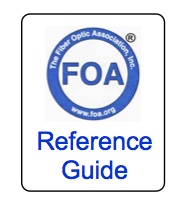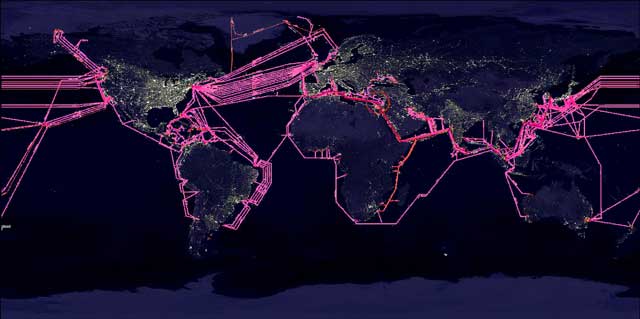

| A
Short History Of Modern Telecommunications This is not a comprehensive history of the phone system, but a overview/timeline to provide some perspective as to how modern telecommunications has developed. Additional reading: A Timeline of Fiber Optics by the FOA and the video The History of Fiber Optics from the FOA lecture series. Modern telecommunications - which we shall define here as communications using electrical or electronic transmission of signals - should probably start with the telegraph. Lots of experimenters were able to send signals over wires soon after the discovery of how to transmit electricity, but it was Samuel F. B. Morse who made it a communications medium by inventing a code for transmitting text, creating a growing market for the telegraph in the 1830s and 1840s.. The telegraph grew rapidly on every continent, but connecting continents was not as easy. The telegraph expanded on land very rapidly, often following the railroads, But it took many decades before a transatlantic telegraph cable could be built. The first transatlantic telegraph cable was developed by Cyrus West Fieldís American Telegraph Company and installed from Ireland to Newfoundland in 1858. It only lasted 3 weeks. It took to 1866 to get reliable connections. The telegraph became more feasible for worldwide communications thanks to an invention by Guglielmo Marconi, wireless transmission. The first transatlantic wireless telegraph signals were demonstrated in 1901. Transmitting the human voice proved to take longer to develop, but Alexander Graham Bell is credited with the invention of the phone in 1876. The phone proved much more popular with the masses than the telegraph because it was more user friendly. Soon cities were stringing wires to connect early users of the phone and soon switches were installed to allow users to connect those they wanted to talk with. It was not long before large phone company offices were needed to switch all the phone calls being made. Providing voice communications worldwide proved more challenging than the telegraph. A breakthrough came with the invention of the vacuum tube by Dr. Lee De Forest. Amplifiers based on vacuum tubes allowed regeneration of signals to make long distance telephones possible - a New York to San Francisco connection was demonstrated as early as 1915. As the network expanded, automated switching was developed to handle connecting the calls, starting in 1921. Marconi's wireless was also developed to handle voice calls, again utilizing the vacuum tube amplifier. Wireless voice connecting the US and France was demonstrated in later 1915, although it would take ten years before commercial service transatlantic was available. Amplification of voice signals sent over copper wires had problems with noise. In the late 1940s, Bell Labs mathematician Claude Shannon published a paper showing that one could overcome these problems by digitizing the analog voice signal and furthermore, he showed how to predict the information carrying capacity of a circuit. Even today "Shannon's theorem" is often quoted in discussions of digital transmission of data. Shannon is one of the real stars of technology in the 20th century and learning more about him is an interesting pursuit. Around the same time, other Bell Labs researchers, William Shockley, John Bardeen and Walter Brattain made another monumental invention - the transistor - that replaced the vacuum tube, but also made possible many other modern technologies including the integrated circuit that made modern communications possible. Remember we discussed how hard it was to build a transatlantic telegraph cables? It took even longer to successfully install a transatlantic phone cable Ė the technology was much more complex. Finally in 1955, AT&Tís TAT-1 ran from Newfoundland to Scotland and offered only 36 voice channels. Now we are in the era of the "Space Age" and in 1962, AT&T and NASA launched the world's first communications satellite, Telstar, opening a new era of telecommunications where technical competition between landlines (copper in this era), terrestrial microwave and satellites competed to build the telecom networks of the future. The 1960s saw the integration of the transistor into the phone system with the first electronic switching systems and the beginnings of digital transmission. It also saw the development of fiber optics, not all done by Bell Labs. Charles Kao, while at STL in the UK, figured how to enhance fiber bandwidth and distance capability to make it useful for telecommunications, a project for which he was a co-winner of the Nobel Prize in 2009. Meanwhile, it took Corning Glass Works to figure out how to manufacture fiber that would actually work for communications. These three are the team leaders that made it work. In fact many others worked on making fiber optics a viable technology. Russians invented the semiconductor laser for transmitters, AT&T developed those lasers and designed and built transmission systems and fiber optic cables. All this culminated in two 1976-77 installations of actual working fiber optic transmission systems, in the coal tunnels under Chicago, IL, USA and in Martlesham Heath, UK. While fiber optics was ready to take off, there were some more key elements in the technological development. About the same time that AT&T was doing fiber optic field trails, semiconductor companies were working to integrate the circuits that digitize voice for transmission. Several CMOS IC manufacturers introduced ICs that reduced the function of digitizing and reconverting signals from the analog phone system from system size to ICs the the size of your fingernail and costing only a few percent as much. The early 1980s fiber optic networks used multimode fiber since that was the best that could be made. Links of ~15km were possible with 850nm lasers but 1310nm lasers were developed to allow longer links or an early version of wavelength-division multiplexing. By 1984, singlemode fiber was commercially feasible and the invention of the ceramic ferrule for connectors in Japan caused a virtually overnight changeover to singlemode fiber for telecom. Lasers at 1550nm came shortly thereafter for even longer links. Remember how it took about 80 years for the first transatlantic copper telephone cable? For fiber it was a tenth that time. TAT-8 was installed in 1988 and operated until 2002. Today there are over 300 submarine cables that connect the world - satellites are only used in remote areas and microwave wireless is limited to remote areas where cables are too expensive to install.  How we communicate today. NASA image updated by FOA to add submarine cables. References: Telephone, The First Hundred Years, John Brooks The Victorian Internet, Tom Standarge City of Light, Jeff Hecht Table of Contents: The FOA Guide To Fiber Optics and Cabling |
|
|